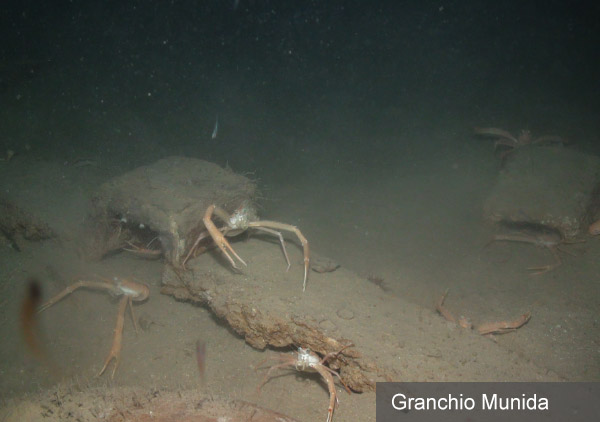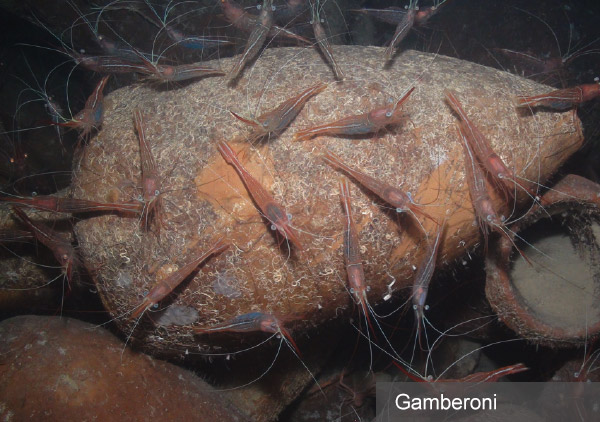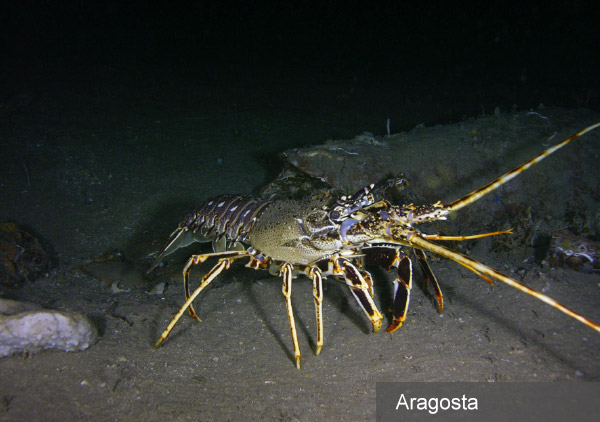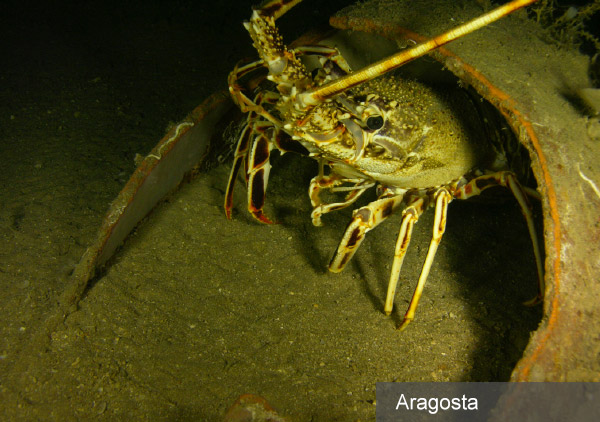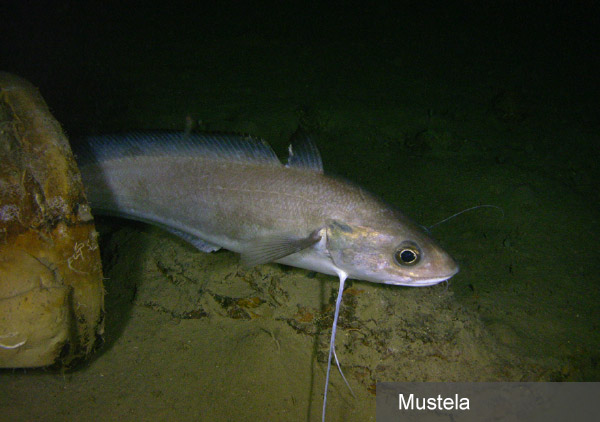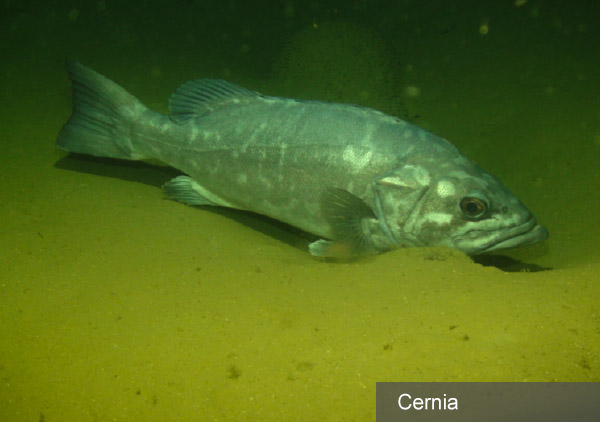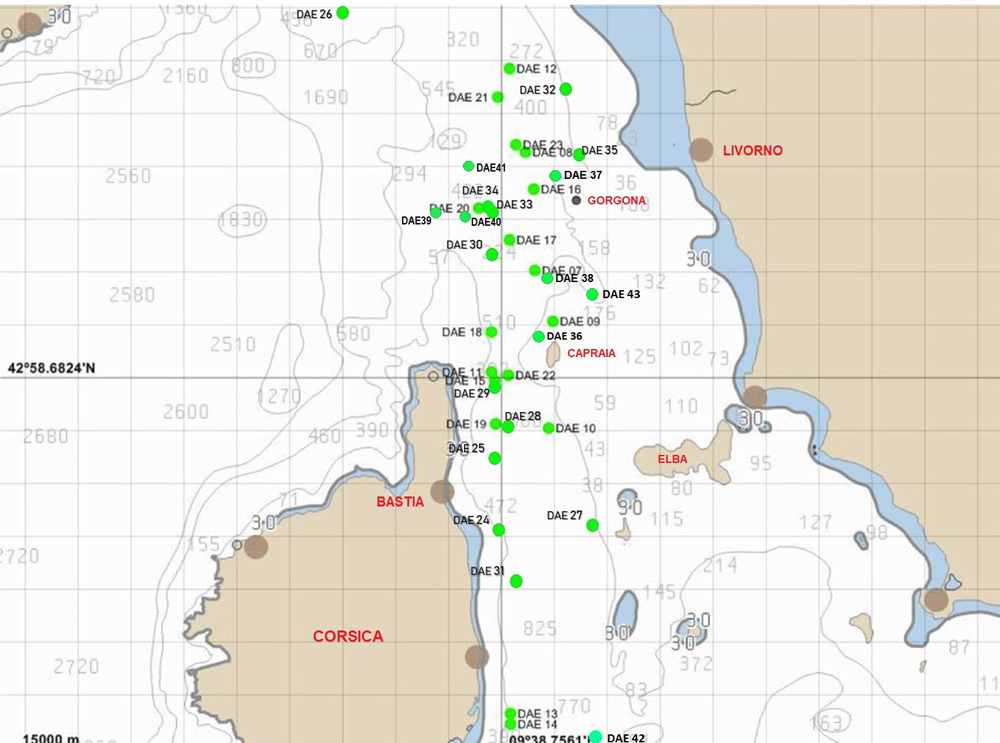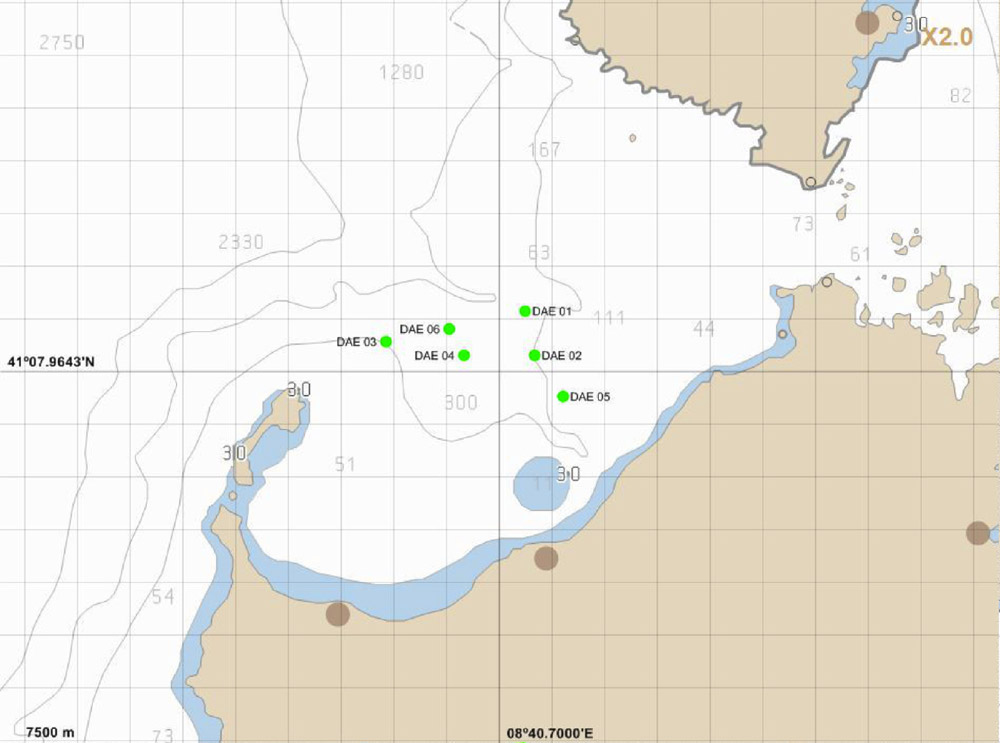Ancient Wrecks

Ancient Wrecks
For over 10 years, DAEDALUS catamaran has been sailing the Tyrrhenian Sea, testing apparatuses and instruments for great depth explorations.
2002
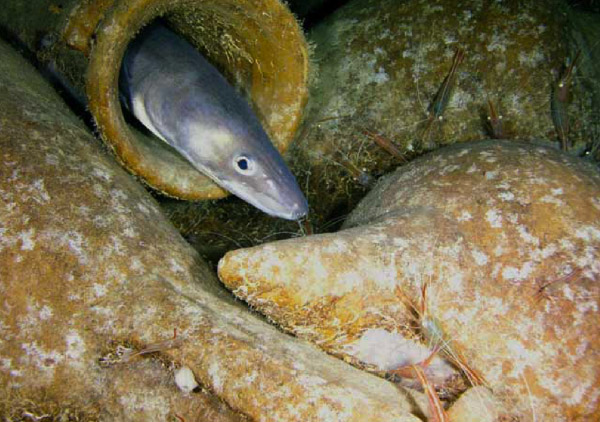
In 2002 the special long range side-scan sonar revealed the presence of an object at a depth of -320 meters on the brink of a submerged canyon in the Gulf of Asinara, between Corsica and Sardinia. There is only one way to find out what it exactly is: dive down to inspect it.
At that time on board of the catamaran there was the PLUTO UX, the first Pluto; the prototype which was developed in 1980 and then served as an experimental platform for all subsequent developments.
The PLUTO UX has been designed to reach depths of -300m but it had sufficient margin to exceed its depth limit in order to inspect that contact at -330m.
Further additional steps were necessary to determine the precise position of the contact by means of cross checking various sonar bearings, then the catamaran was stopped just above the point and its dynamic positioning system activated to automatically hold position. The PLUTO was launched vertically down, pulled downwards by the weight of the expendable ballast.
Once on the bottom, the ballast was released through a remote control and the vehicle was then able to move freely. At this point the navigation sonar was switched-on and surrounding inspection was performed beyond the visibility range. A few tens of meters away, the presence of the contact was detected and the Pluto navigated in that direction. With caution, as not knowing the nature of the object could lead to entanglement, the contact was approached and out of the darkness emerged piles of ancient amphorae.
Most of the cargo of this ancient Roman ship is composed of amphorae which appear to be the type IIB Beltran, original of the Betic area (Spain, Cartagena) and presumably containing fish sauce "garum". The ship was evidently headed for Rome and during the passage through the Strait of Bonifacio was caught in a gale which caused her’s sinking. It looks to be dated between the second and third century after Christ. This wreck appears to have been repeatedly damaged by the passages of sea bottom dragged fishing nets which have distorted the entire top layer of amphorae, pieces of which seem to have been recently broken.
2007
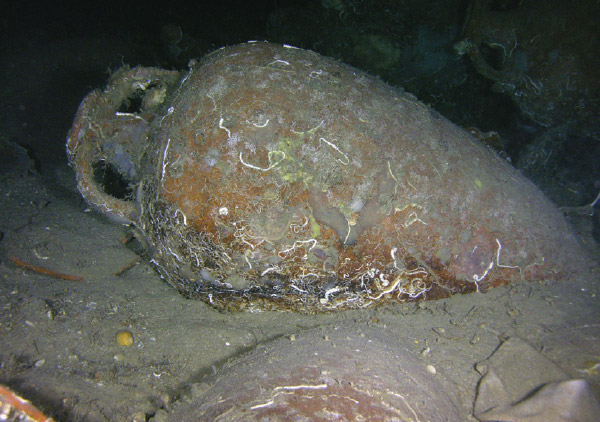
In 2007, the DAEDALUS catamaran, crewed only by Guido Gay and a second person, explored the depths of the Asinara Gulf using an improved version of the ship mounted side scan sonar that unveiled a second ancient Roman wreck at a depth of -190m. The contact was immediately inspected by the PLUTO UX which revealed a moderate amount of amphorae of the Almagro 51 type, dating to the fourth century AD, as well as a pile of concretion which could be assumed to be a load of minerals.
These findings have been regularly registered and reported to the local Archaeological Heritage Superintendence of Sassari under the names DAEDALUS 1 and DAEDALUS 2. In the summer of 2007 further inspection was carried out on the contacts and together with the local authorities a number of amphorae were recovered.
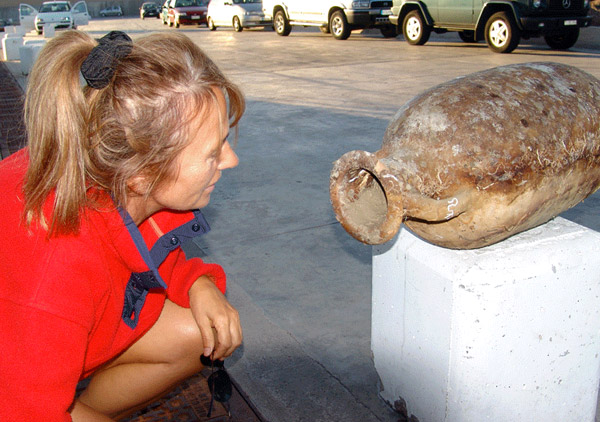
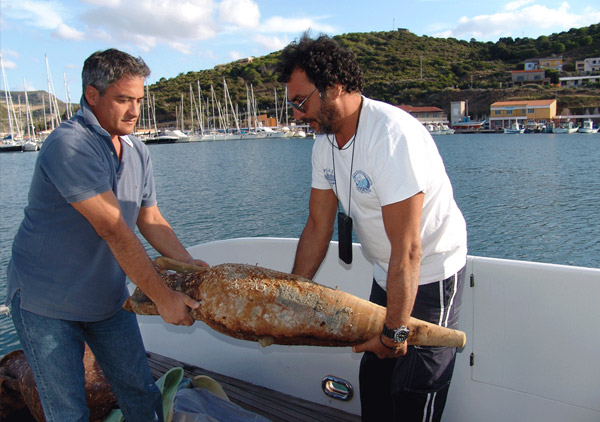
2010
In 2010 Guido Gay embarked on board the catamaran DAEDALUS the new PLUTO PALLA; a remotely-controlled underwater vehicle capable of diving down to -2000 m and with remarkably innovative characteristics. This revolutionary vehicle makes it possible to continue the search for the wreck of the battleship Roma. The exploration campaign is intensified and dives on side scan sonar contacts immediately prove the vehicle’s worthiness by uncovering further five ancient Roman wrecks. Many of the contacts only evidenced rock formation, but when from the sea bottom darkness emerge piles of amphorae, it is always a thrill.
The DAEDALUS 3 wreck was identified at a depth of -480 m. The load was varied and included Dressel 20 amphorae, at the time used to transport oil and Almagro 51 amphorae for carrying “garum”. This well identifies the Betic origins dating them on the period around the third century AD. These discoveries proved the existence a of a well-defined sailing route between Spain and Rome, which crossed the open seas and the dangerous passage through the Strait of Bonifacio.
At a depth of -360 m the DAEDALUS 4 has been discovered. Amphorae of Greek-Italic origin, therefore dated to the republican period BC are seen. Additionally three sets of lead anchors were identified.
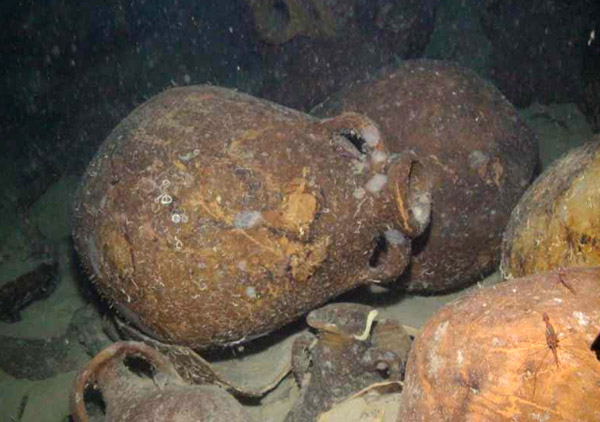
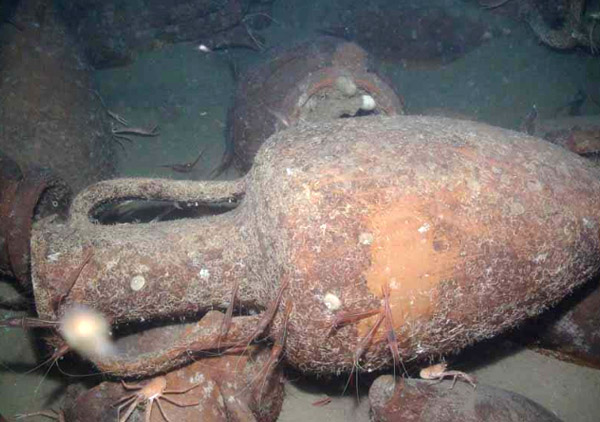
While carrying on tests with the new long-range sonar, the nature of a hazy patch was checked out among a series of rocks emerging from a ridge on a muddy bottom. And here the DAEDALUS 5 wreck was discovered at a depth of -150 m. The wreck is an old wooden boat, old but not ancient, carrying square blocks of local granite pink trachyte.
Finally, always in the Gulf of Asinara, a faint sonar contact at a depth of -820 m and only visible from certain directions, revealed to the PLUTO PALLA camera to be a new deposit of amphorae, the DAEDALUS 6. This has been the deepest and most difficult to find as lying on a muddy slope. But this wreck is, in our opinion, the most interesting due to the fact that, being it at great depths, it was not damaged by fishing nets, and that it is composed of a mixed cargo of amphorae revealing a coastal sailing path from Lusitania to the Betic and way up to Gaul followed by the fatal descent through the Bonifacio Strait. Of particular interest was the discovery of two new types of amphorae never seen before.
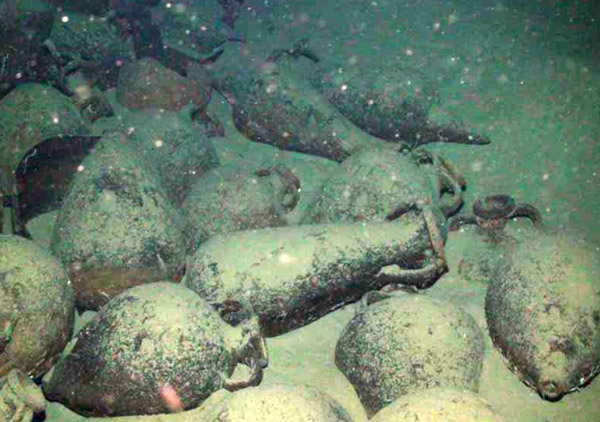
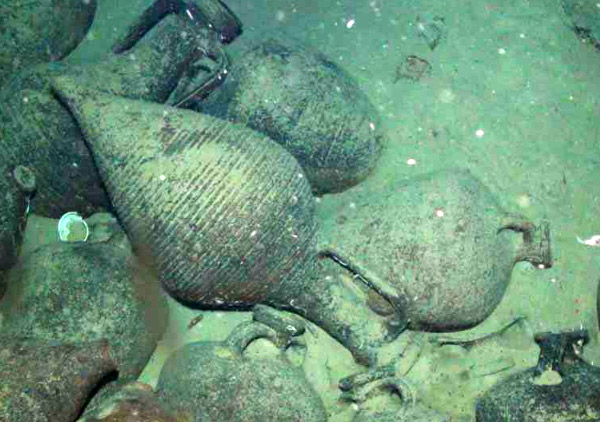
Given the abundance of discoveries, the Superintendent of Sassari decided to make sample recoveries on each of the located wrecks, so Guido arranged in the DAEDALUS workshop a specific tool that allowed the PLUTO to hook up to the handles of the amphorae and lift them up to the surface without any damage. To reach the goal the PLUTO operations were also assisted by diving the PLUTO 1000 at the same time.
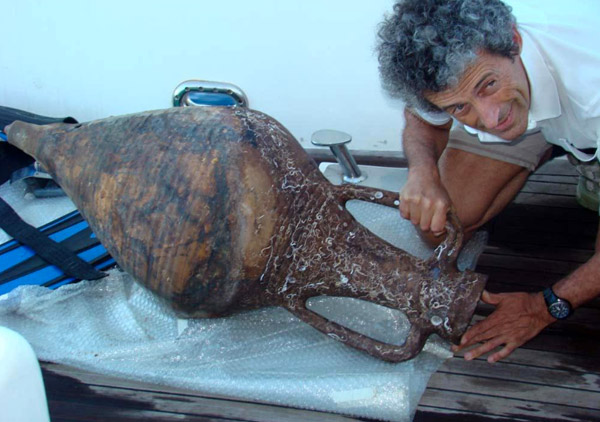 On that same occasion one of the two strange amphorae was recovered from a depth of -820 m.
On that same occasion one of the two strange amphorae was recovered from a depth of -820 m.
In the same year, 2010, the Daedalus on the way back from Sardinia to its home port of La Spezia, run across two additional interesting Roman shipwrecks:DAEDALUS 7 off the island of Capraia at a depth of -400 m, carrying a cargo of ancient Greek-Italic amphorae.
The feather like structure grown on the amphora is an uncommon form of black coral: Parantipathes larix.
DAEDALUS 8 off the island of Gorgona at a depth of -520 m, carrying cargo of amphorae model Dressel 1.
Both these deposits are relatively damaged by trawling fishing nets and have been duly reported to the Superintendence of Tuscany and at the moment no further information is available.
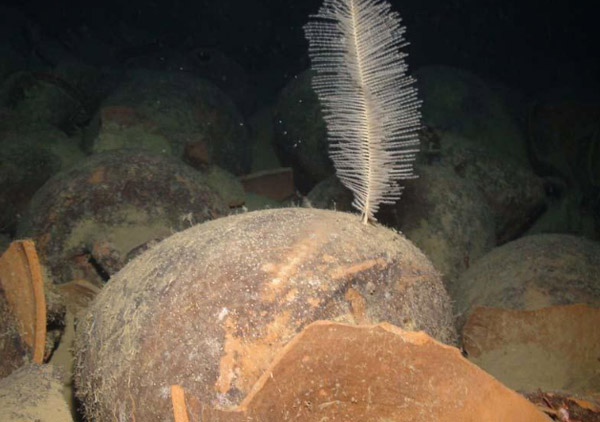
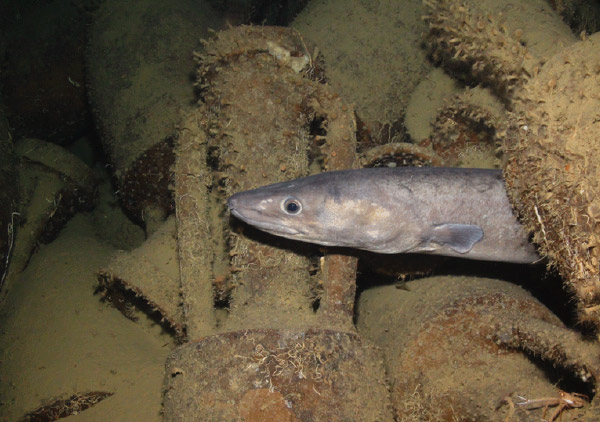
2011
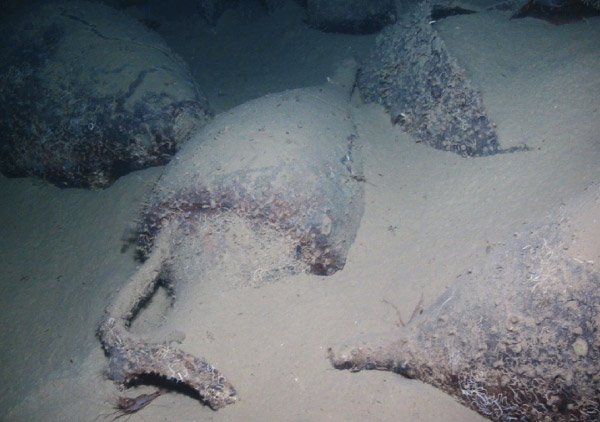 In 2011, as usual during random transits of the catamaran, and while experimenting the new developments realized during the winter period, four additional wrecks have been identified.
The DAEDALUS 9 just north of the island Capraia at a depth of -150 m, a field of amphorae almost completely devastated by the passage of trawled fishing nets.
Followed by the DAEDALUS 10 to the South of the Island of Capraia at a depth of -410 m, with a seriously damaged cargo of Greek-Italic ancient amphorae.
In September, en route back to its home port the DAEDALUS 11 was uncovered at a depth of -300 m West of the Capraia Island in Corsican waters. Unfortunately also this wreck is positioned on a fishing route, which during the years have contributed to its destruction.
Another unexpected and unlikely finding DAEDALUS 12 at a depth of -400 m in Ligurian waters South of the island Tino, identified a cargo of amphorae dating from to the ancient Greek-Italic II / III century BC. Also this sight has been damaged by fishing, but nevertheless still considered interesting and which has been given a certain amount of attention.
In 2011, as usual during random transits of the catamaran, and while experimenting the new developments realized during the winter period, four additional wrecks have been identified.
The DAEDALUS 9 just north of the island Capraia at a depth of -150 m, a field of amphorae almost completely devastated by the passage of trawled fishing nets.
Followed by the DAEDALUS 10 to the South of the Island of Capraia at a depth of -410 m, with a seriously damaged cargo of Greek-Italic ancient amphorae.
In September, en route back to its home port the DAEDALUS 11 was uncovered at a depth of -300 m West of the Capraia Island in Corsican waters. Unfortunately also this wreck is positioned on a fishing route, which during the years have contributed to its destruction.
Another unexpected and unlikely finding DAEDALUS 12 at a depth of -400 m in Ligurian waters South of the island Tino, identified a cargo of amphorae dating from to the ancient Greek-Italic II / III century BC. Also this sight has been damaged by fishing, but nevertheless still considered interesting and which has been given a certain amount of attention.
2012
In 2012, the DAEDALUS sailing south to Sardinia in its search of the wreck of the Battleship Roma, came across, in the waters of Corsica, of an additional Roman shipwreck DAEDALUS 13 at a depth of -340 m with a cargo composed for half of amphorae and the remaining half of pottery, jugs and lamps.
During a night navigation, heading back north from Sardinia, always sailing with calm weather along the coast of Corsica, decision was taken to investigate an unusual sonar echo on the slope of a canyon and there the Roman shipwreck DAEDALUS 14 has been discovered at a depth of -400 m.
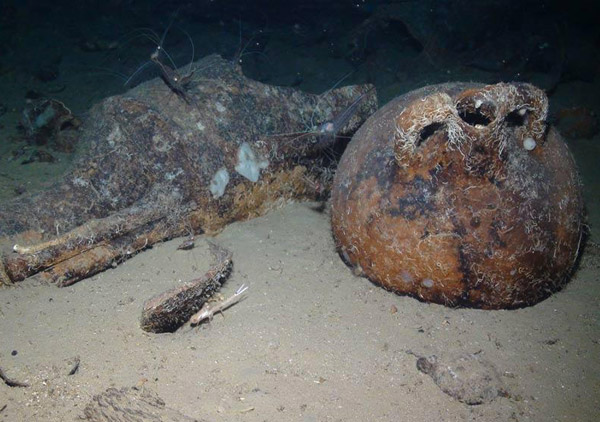
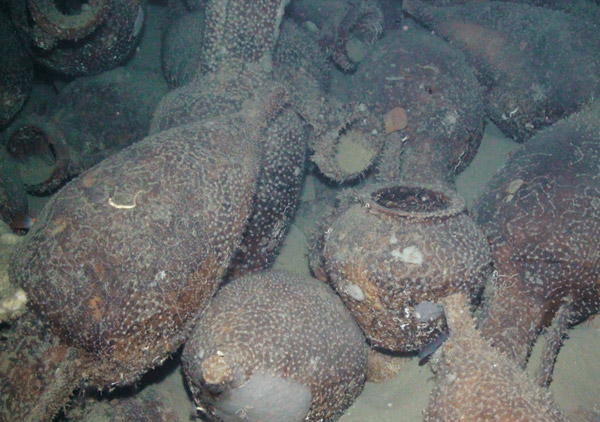
2013
In 2013 new discoveries are always happen in the area of Tuscan Islands and Corsica.
DAEDALUS 15 in the Macinaggio to -325 m depth. Prevalence of Gallic 4 amphorae, dating from the second century A.D.
DAEDALUS 16 off the island Gorgona to -465 m depth, cargo of Dressel 1 amphorae.
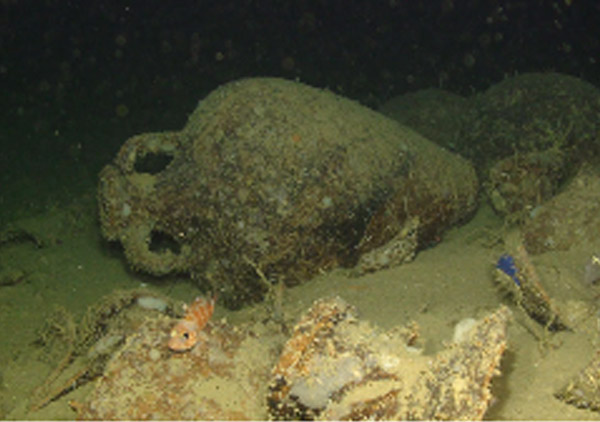
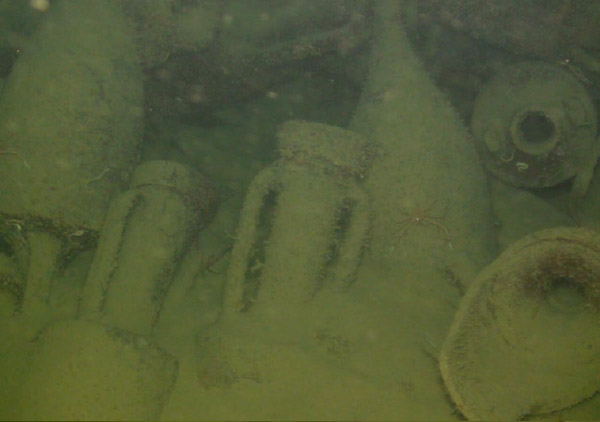
Off the coast of Gorgona at a depht of -440 m, very interesting for a mixed cargo of Rodie amphorae, of Punic amphorae and some elegant shape pitchers. It seems to be dated to the first or second century BC. Ship coming from the East, perhaps direct perhaps in Marseille. About this wrecks, with the direction and supervision of the Superintendence of Cultural Heritage in Tuscany, we have performed the recovery of an amphora Rodia. Inside of the amphora we have found abundant remains of the content: a quantity of small seeds. Soon it is expected the recovery of a jug, always by way of the sampling.
DAEDALUS 18
North of Capo Corso at a depht of -360 m, what appeared to be a pile of rocks on a flat and muddy seabed, to an examination of the French Superintendent proved to be the load of obsidian blocks of an ancient sunken ship. Two amphoras testify of the sinking.
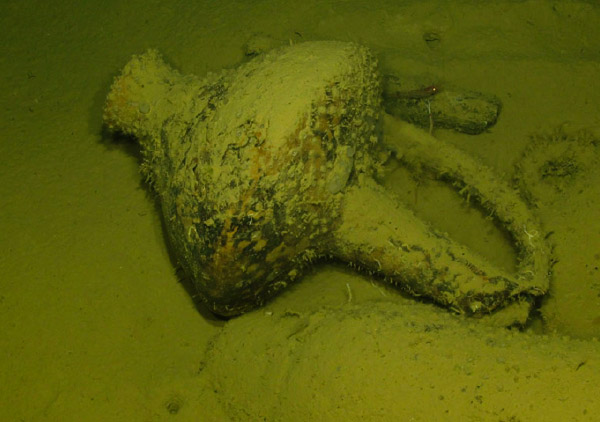
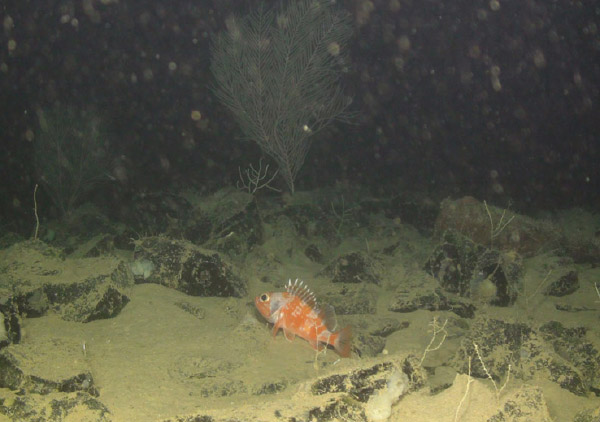
2014
DAEDALUS 19
Off the coasts of Bastia at a depht of -425 m
The amphorae were scattered because of trawl fishing.
DAEDALUS 20
West of Gorgona at a depht of -400 m a cargo of Dressel 1 amphora and the view of a part of anchor.
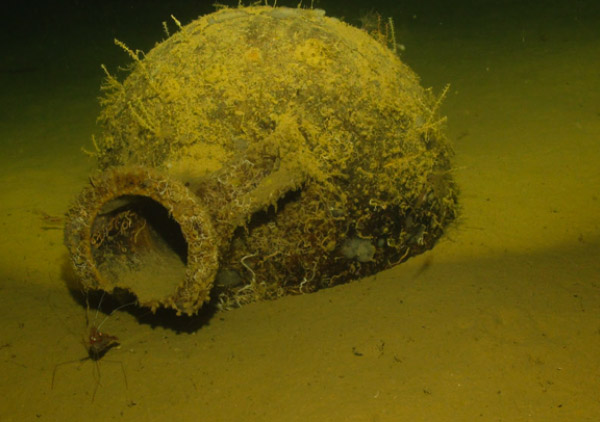
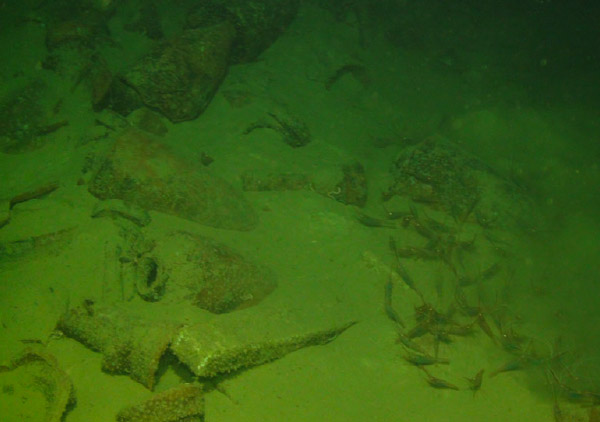
DAEDALUS 21
In the Ligurian waters, at a depht of -500 m
an ancient well preserved cargo, not damaged by trawling, and the discovery of 4 anchor stocks (that define the position of the bow of the wreck), Dressel 1 amphorae and vases dated the second century B.C.
DAEDALUS 22 fra Capraia e Corsica, a -380m
Carico uniforme di anfore Almagro 51C per salsa di pesce. Proveniente dalla Lusitania, III sec.d.C.
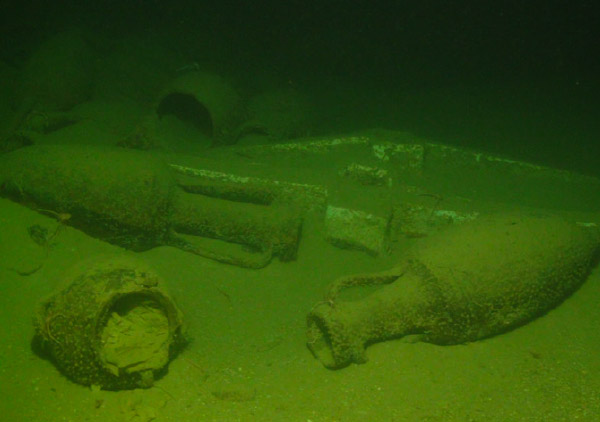
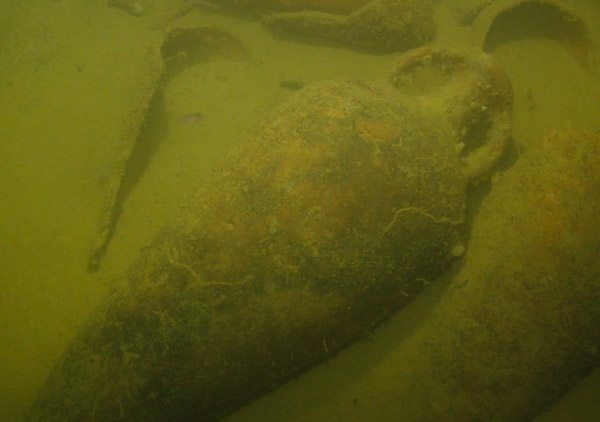
DAEDALUS 23
27 miglia a Ovest di Livorno,
a -515m
giacimento molto ben conservato
perché poco frequentato dai pescherecci.
Anfore di vari tipi, molte senzapuntale
ma con fondo piano.
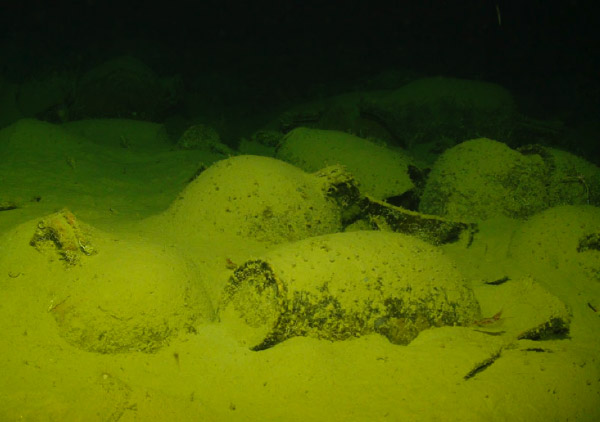
2015
DAEDALUS 24 al largo di Bastia,
a -365m
carico uniforme di Dressel 1B
DAEDALUS 25 al largo di Capo Sagro, a -480m
anfore greco italiche
questo è il relitto della cernia (30kg)
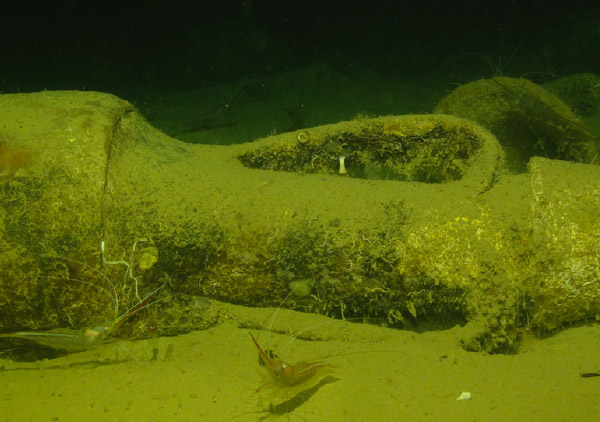
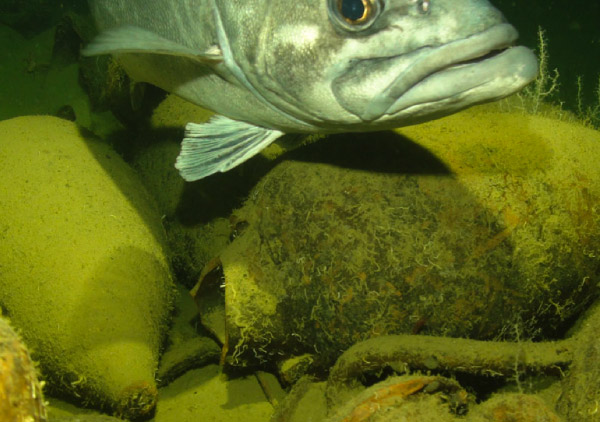
2016
DAEDALUS 26
A fishing boat of Santa Margherita found in its nets 4 Roman amphorae. Very correctly they delivered them to the Carabinieri.
The "Soprindendenza of Liguria” took the findings and contacted me to locate the field. The fishing boat had given references of its route, but didn't know where it had met the wreck. So I took the references and with only one sonar pass I have located the wreck about 20 miles south of Portofino.
The PLUTO PALLA immediately sent to the deep see, discovered a substantial mound of Dressel 1 amphorae with the unusual presence of what I supposed to be "brindisine amphorae”.
At 720 meters deep, there are no red prawns and the big sea eels their predators, instead I could see a large monkfish, squatted among the shards, waved his bait.
Also it appeared a mysterious "needle fish" of which I have just taken a blurred picture.
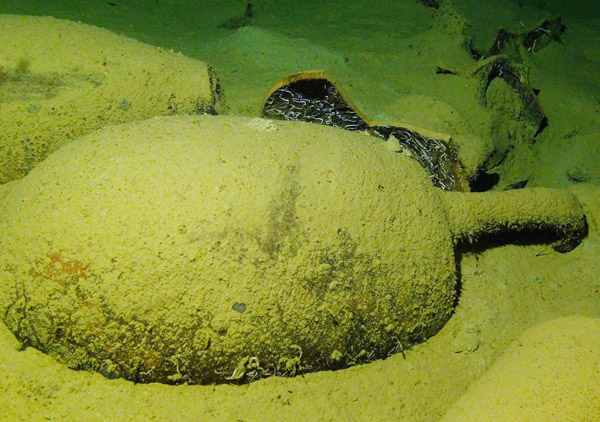
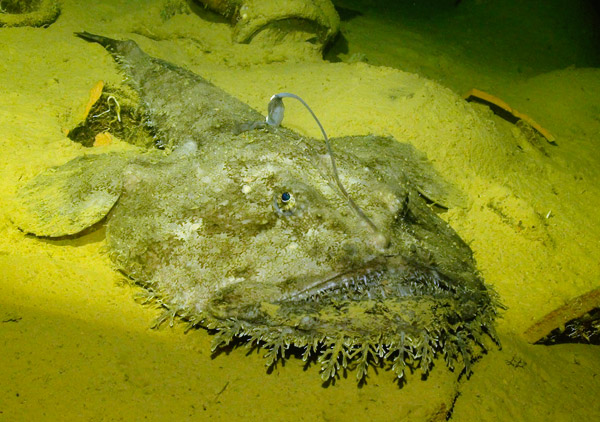
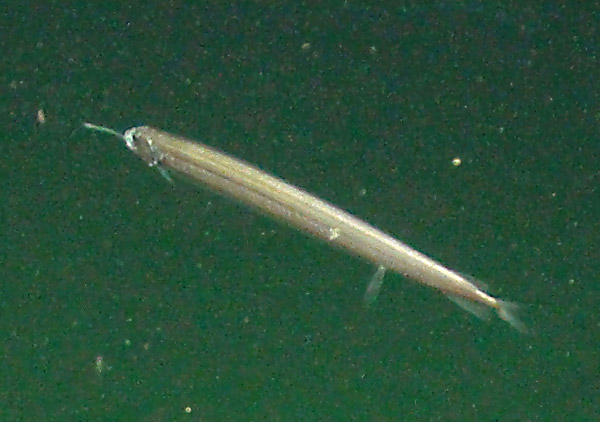
DAEDALUS 27
Returning to La Spezia from Sardinia I sent the new MULTIPLUTO to see an old sonar contact detected ten years ago. I discovered a new Roman ship wreck.
This discovery located to 640 meters deep, to the west of the island Pianosa, is absolutely intact: no fishing trawl has ever ruined it.
It's
very significant if compare with the devastation of almost all other shipwrecks. For some prawns are deleted exhibits and artifacts from two thousand years ago, almost as a deliberate devastation of today's Muslim fanatics.
This field shows a vessel carrying of Dressel 1 amphorae still intact. Two anchor stocks are also recognizable in the original position in the bow (of course every part of wood has disappeared).
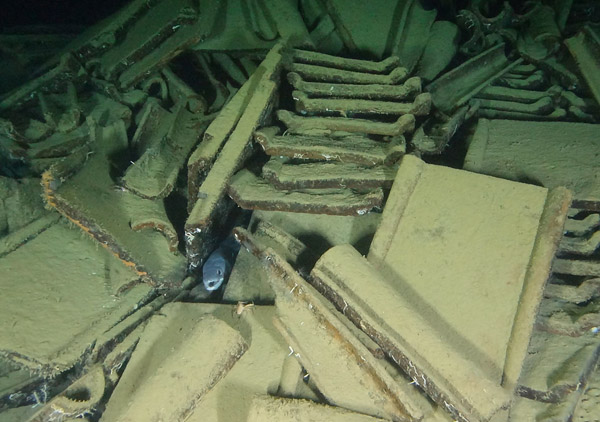
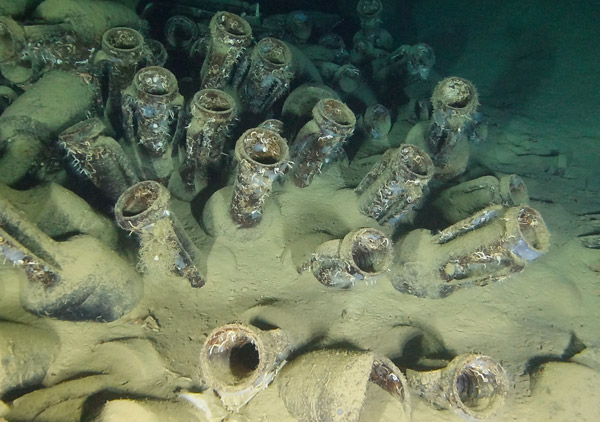
DAEDALUS 28
A tenuous Sonar contact off Corsica’s Cape Sagro and a MULTIPLUTO dive, discover a sunken Roman ship, cargo of which consisted of amphorae and a large quantity of stone like objects, scope and object of which still remains to be discovered.
Depth of 590 meters.
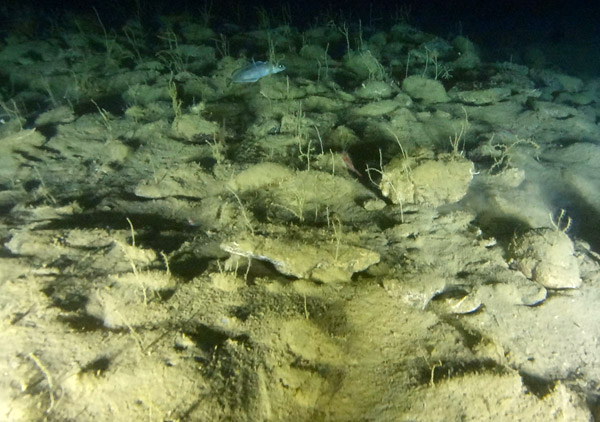
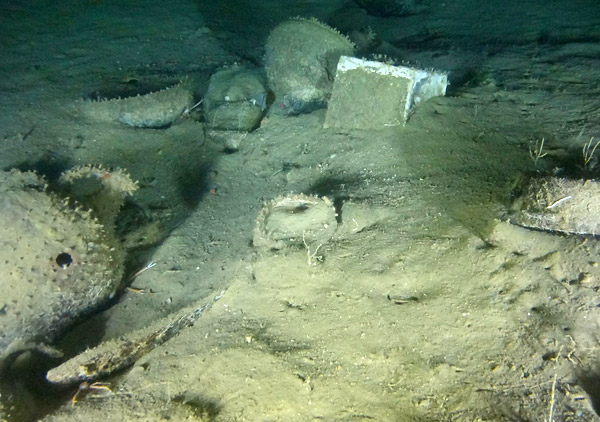
DAEDALUS 29
One last MULTIPLUTO dive to find more remains of sunken Roman ship.
Located at a depth of 340 meters, 7 miles east of Macinaggio, at the extreme north of Corsica.
Being in French waters, I have not been able to perform a detailed inspection, all I was able to witness in the submerged valley was a series of amphorae dragged there by bottom trawls. I was not able to inspect the main field but I detected the presence of Dressel 1C in combination with “Brindisine” type amphorae. If confirmed by archaeologists, said not well known combination, could substantiate the existence of new ancient maritime trade routes.
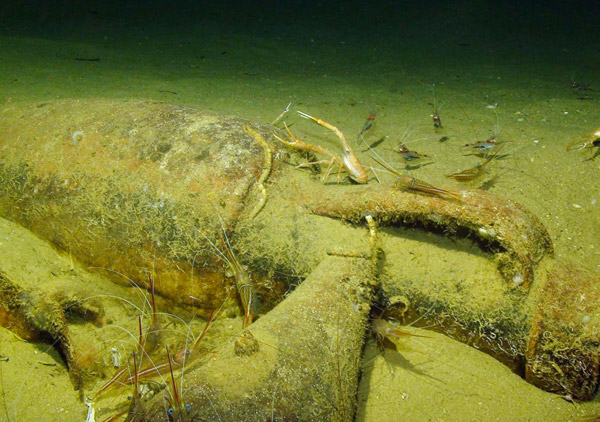
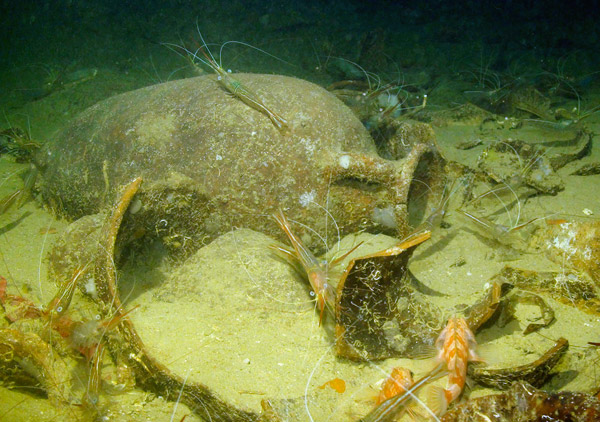
A good weather interval in the month of September allowed sailing back on DAEDALUS 17, together with the Superintendence of Tuscany, to recover some previously identified artifacts. In the vicinity, there was an detected but never explored sonar contact. A quick dive to -460 meters and MULTIPLUTO discovered a vast deposit of well-preserved amphorae including amphorae of the Oberaden 74 and Laetana 1 type of Spanish origin and dating back to the first century AD.
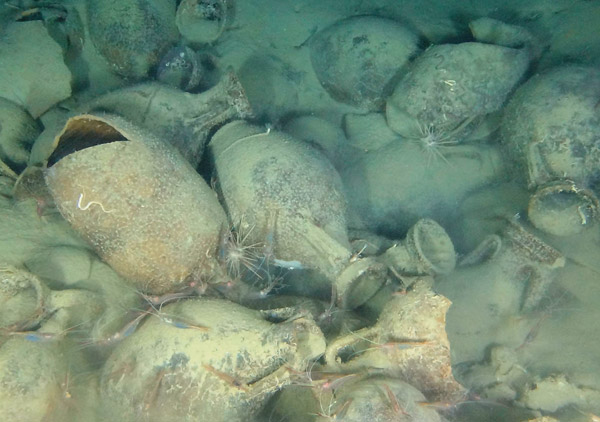
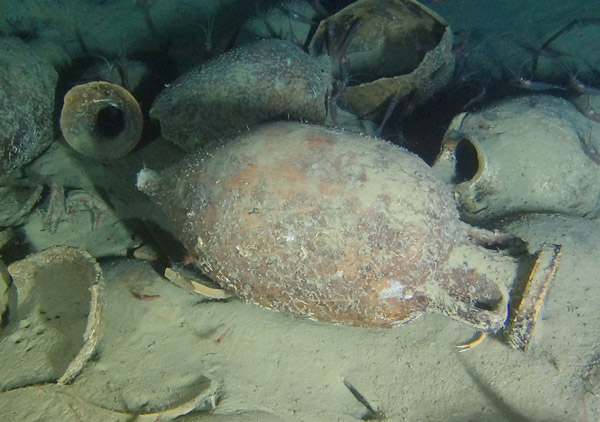
DAEDALUS 31
A deposit discovered in 2015 and neglected, now seems to consist of the ballast of a Roman ship.
It is a pile of rounded stones like a river or a shoreline. Another reconnaissance will be needed to find out more details.
Depth 300 m northeast of Campoloro in Corsica.
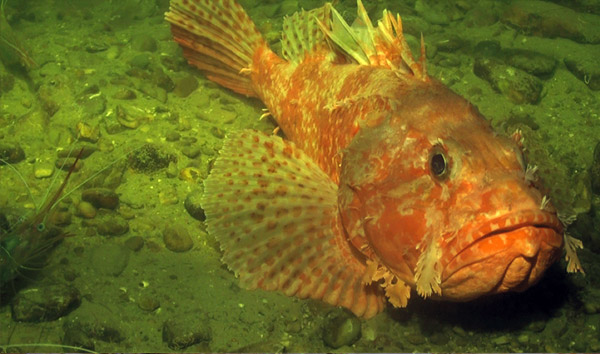
2017
DAEDALUS 32
Every season the DAEDALUS leaves La Spezia and heads south. Each time it chooses a different route in order to explore the seabed using the fixed hull side scan sonar. In this way, it widens the surface area of the seabed explored by about one kilometer. In a first step in 2017 it detected a contact at a depth of about 250 m halfway between the port of La Spezia and the Gorgona island, in a region very popular for Viareggio fishing boats. The MULTIPLUTO rapidly dived on the site and it found an important deposit of Dressel 1 type amphorae that place the wreck between the 2nd and 1st centuries BC. Unfortunately the whole exposed part of the heap, about 2 meters high, is devastated by the passage of the trawl nets.
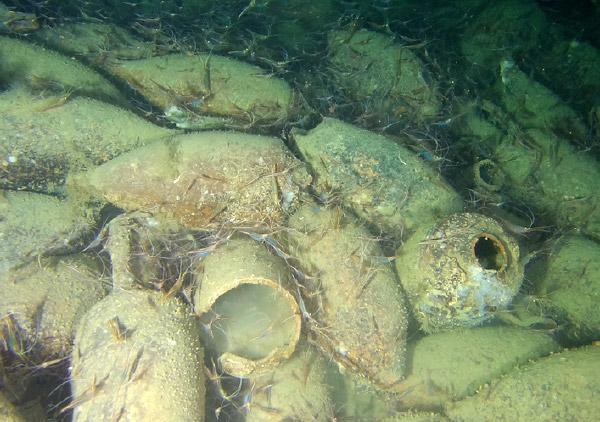
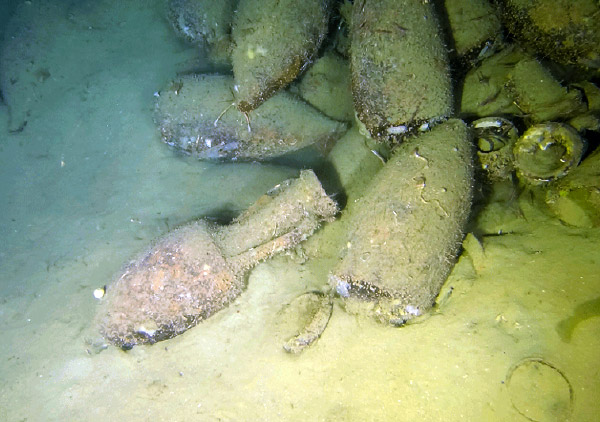
DAEDALUS 33 - DAEDALUS 34
West of the Gorgona at a depth of 380 m the wreck DAEDALUS 20 was found in 2014. During the same period, two other unidentified anomalies were also detected on sonar. This year we went to dive the MULTIPLUTE to see what it was and with great surprise we discovered the remains of two Roman shipwrecks at a very short distance from each other, about 900 meters. It seems rather unlikely that two similar ships, both with a Dressel 1 cargo and same size, have sunk in the same spot at different times. The conjecture seems more likely that they sailed conservatively on the same route and that for example they had a night collision with bad weather. This idea could be proof that at the time it was possible to sail in convoy. Even stranger is the presence of the other wreck Daedalus 20 only 3000 meters further west, always loaded with Dressel 1.
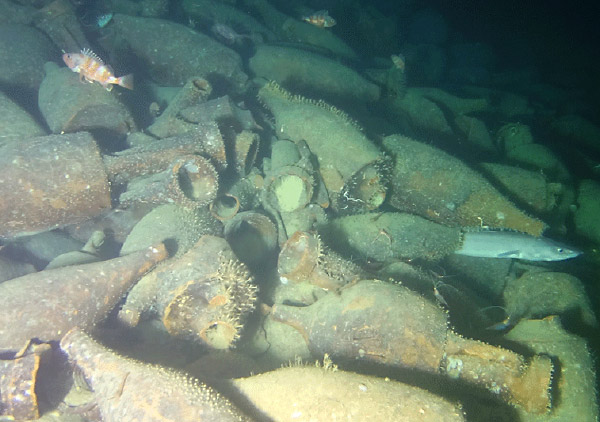
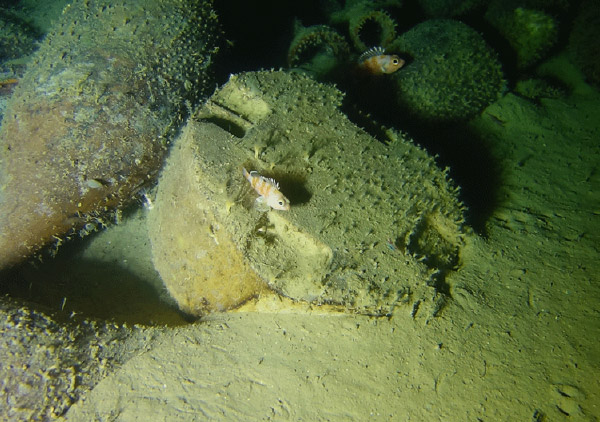
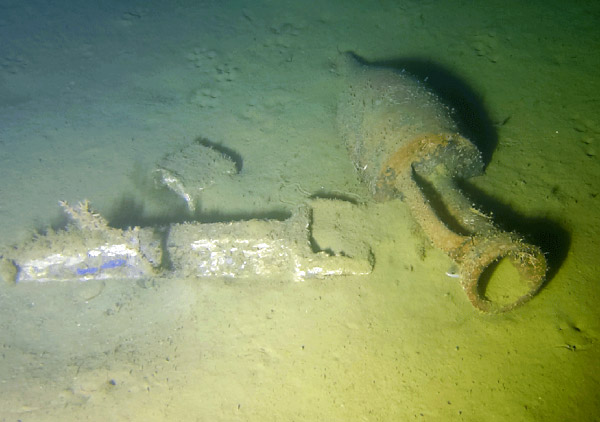
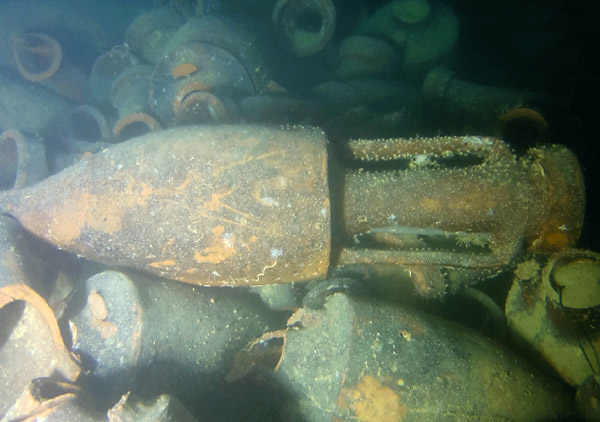
DAEDALUS 35
Latest discovery of Roman wrecks of 2017: a deposit of Dressel 1 amphorae very damaged by trawling, located south of the Tino island at a depth of 315 meters, in the middle of the fishing area of Viareggio boats. The surrounding seabed is upset by the furrows of the diverging nets and one of these was lost and got stuck between the amphorae.
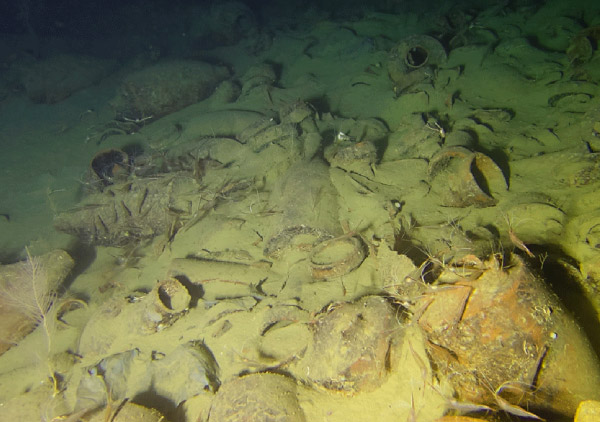
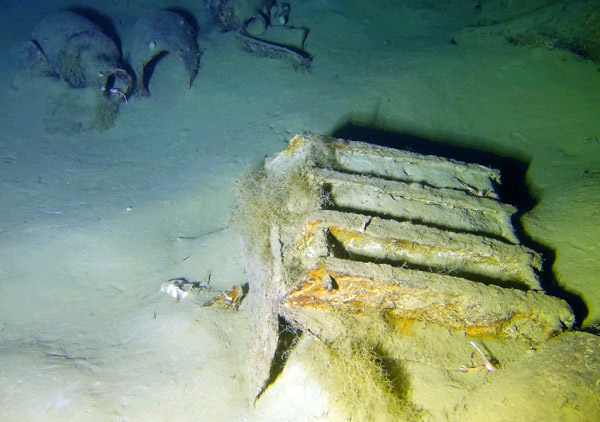
2018
DAEDALUS 36
A few miles North West of Capraia at a depth of 140m, an amphorae deposit was completely devastated by trawling. These are mainly Gallica 4 type amphorae that transported wine from Gaul to Rome in the 2nd century AD.
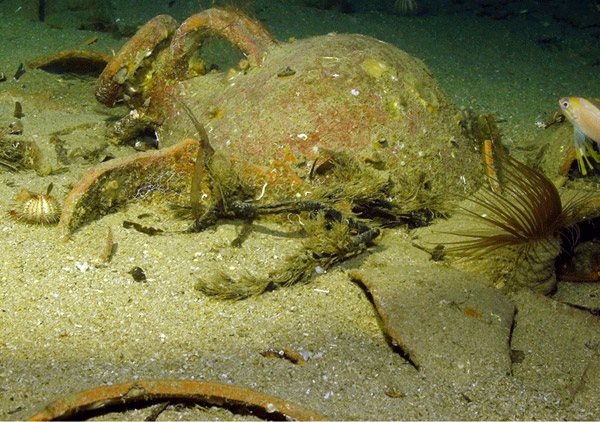
DAEDALUS 37
The stone cargo of a Roman ship presumably left the port of Luni and headed for Rome was found in 280 meters depth, a few miles northwest of the island of Gorgona. These are squared blocks of marble from the Carrara quarries, including a large blank with a shape that is difficult to define. The few Dressel 1 amphorae in the surroundings testify a probably republican period of the wreck, between the 2nd century BC and the first century BC.
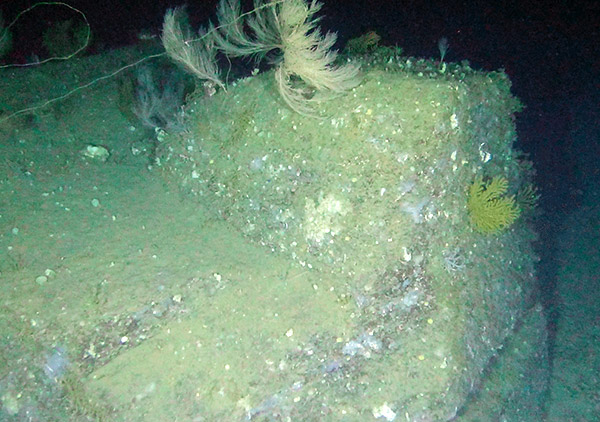
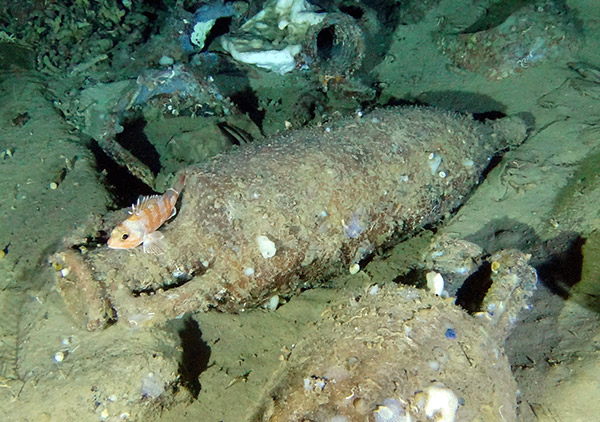
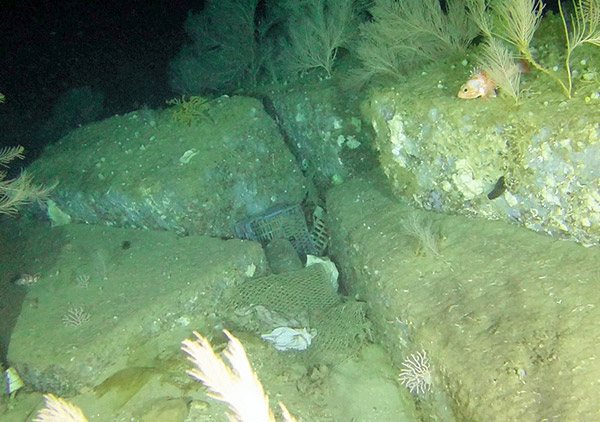
2019
DAEDALUS 38
Navigation to Capraia Island at the beginning of the season. The sonar of the DAEDALUS catamaran detect an evanescent but interesting anomaly. We go around it taking other images with the sonar, the contours are better defined, we decide to stop and launch the MULTIPLUTO vehicle to see what it is: and here appears on the screens the heap of amphorae of yet another Roman wreck. It is a small deposit, not very disturbed by the usual trawl nets, 460 meters deep with amphorae of Betic and Tarragonese origin, including the Dressel 1C, Oberaden 74 and Laetana 1 types. Period between the republic and the empire.
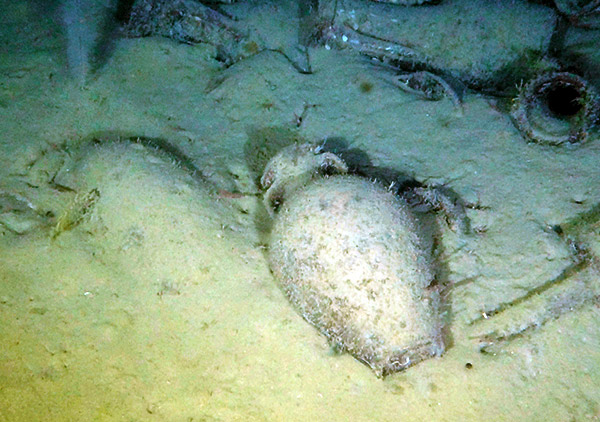
DAEDALUS 39
Second mission of the year from La Spezia to Capraia. Navigating with sonar in operation, suddenly on a depth of 570 meters a small clear signal appears with the typical shape of the Roman wreck. We immediately begin the procedures to launch the MULTIPLUTO and visually check. From the darkness the first amphorae appear confirming the discovery of an ancient Roman wreck.
The deposit is impressive, more than 25 meters long and 2.5 meters high. Uniform load of thousands of Dressel 1A amphorae, a few Lamboglia 2 amphorae, four lead anchor blocks delimit the bow and a whole anchor without a block emerges at the stern. On the top of the heap an isolated and intact bowl. Many recently decapitated amphorae and a piece of net testify to the damage caused by trawling. Approximate dating from the end of the 2nd century BC.
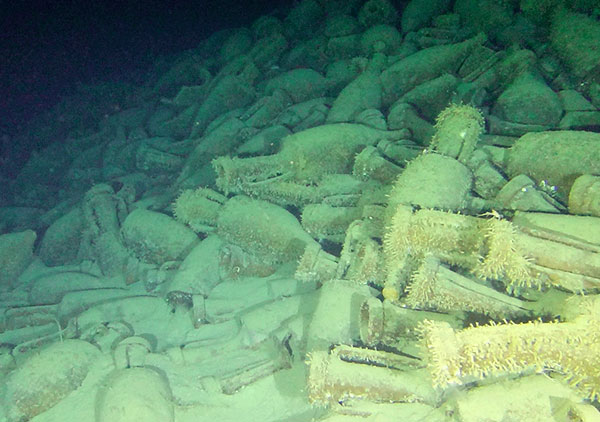
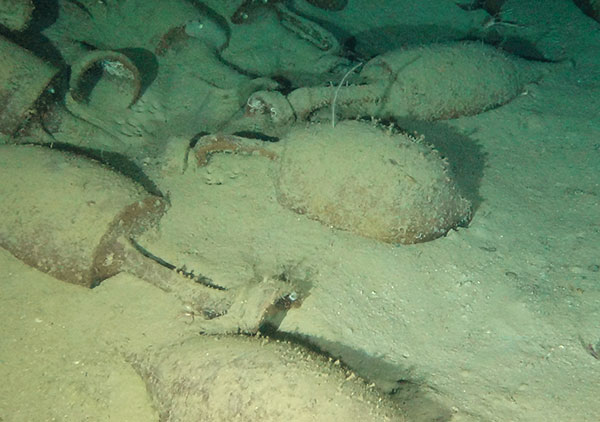
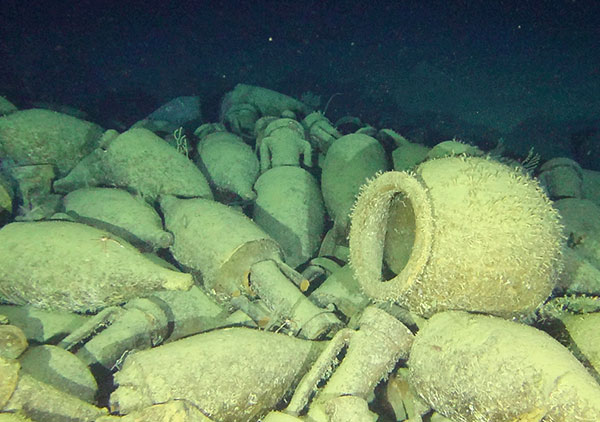
DAEDALUS 40
Third mission of the year for the Daedalus catamaran, sailing from Corsica to La Spezia. The side scan sonar locates, to the west of the Gorgona island, two contacts within easy reach of each other.
At a depth of 500 m a small signal appears with the typical shape of the wreck. Let's immediately start the procedures to launch the Multipluto and check it visually. From the darkness the first amphorae appear confirming the discovery of an ancient Roman ship. The cargo of amphorae of the Dressel 1B and Lamboglia 2 type is rather well preserved, even if some are broken, probably due to the passage of trawl nets. From the type of amphorae transported it can be deduced that the ship belongs to the Republican period, between the 2nd century BC and the 1st century BC.
The images of the Multipluto also show various objects such as plates, jugs and pottery, probably belonging to the crew.
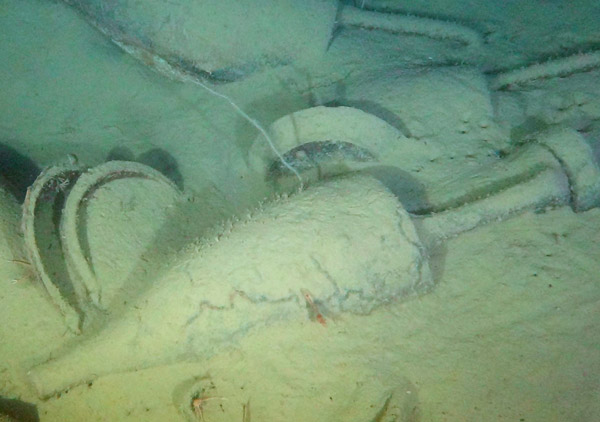
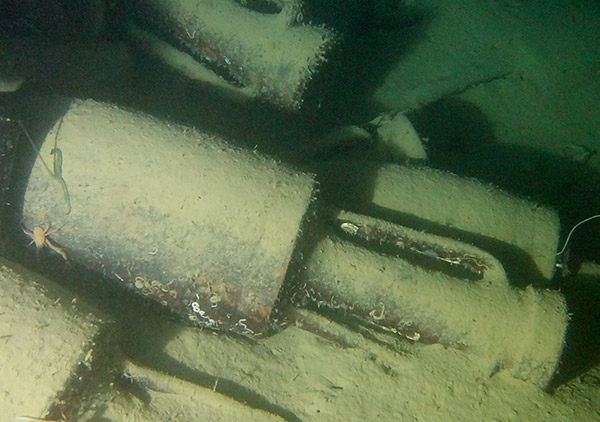
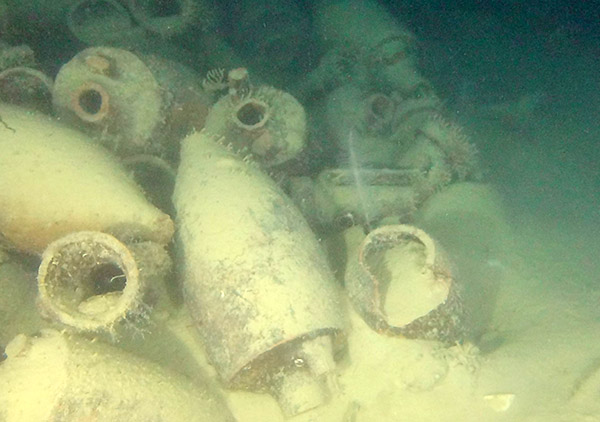
DAEDALUS 41
As part of the same exploration, the side scan sonar of the Daedalus catamaran indicates, in the same area, a second contact at a depth of 430 m. Again we let the Multipluto go down to inspect the seabed. It is another wreck of a Roman ship, loaded with Dressel 1C amphorae, datable approximately to the end of the 2nd century BC. On the seabed there are also plates and other crockery, probably crockery for use by the crew. Although some amphorae are broken, even in this case, the cargo appears to be rather well preserved. An anchor block is clearly visible in the prow of the wreck.
Thanks to these two new findings, the hypothesis that this area, to the west of the Gorgona island, is a real cemetery of shipwrecks, it is seems to be confirmed. Until now 7 Roman wrecks have been found at a very short distance from each other.
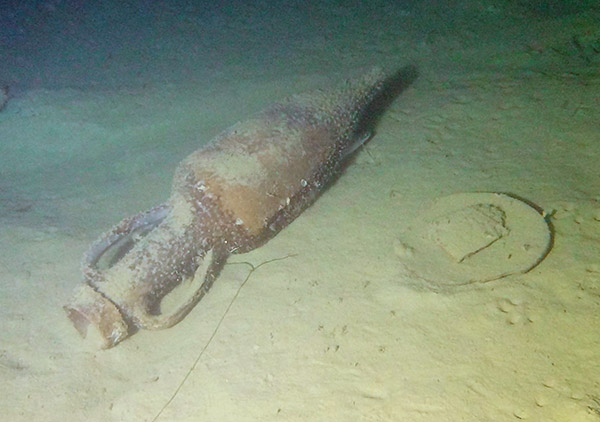
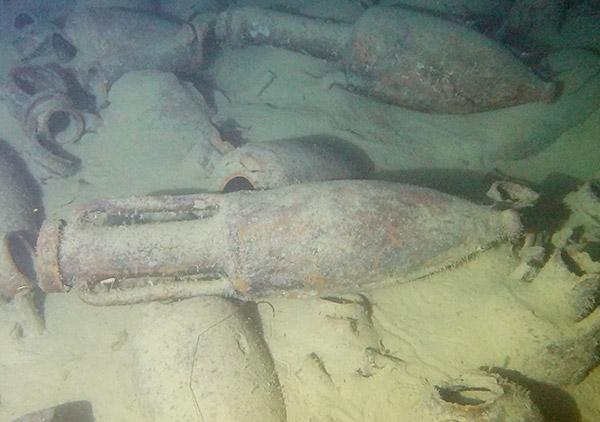
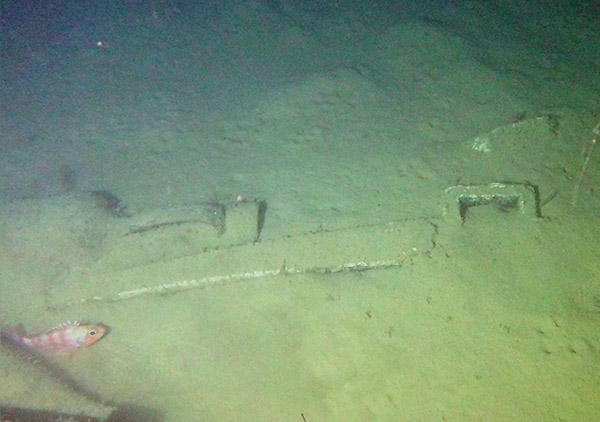
2020
On the way back from Sardinia, our DAEDALUS catamaran passes the Strait of Bonifacio and goes up off Porto Vecchio in Corsica by performing a sonar pass adjacent to a previous one from last year. On a depth of over 700 meters you can see an echo of the usual form of the Roman wrecks. We stop and drop the MULTIPLUTO.
We immediately find a heap of amphorae that which constitute DAEDALUS 42 ancient shipwreck. The cargo is made of Dressel 1 amphorae and Adriatic amphorae, as well as 5 anchor stocks and a quantity of various pottery, which make the find archaeologically very interesting. The biggest surprise lies in observing a wreck that has never been damaged by trawl nets, a quite rare situation.
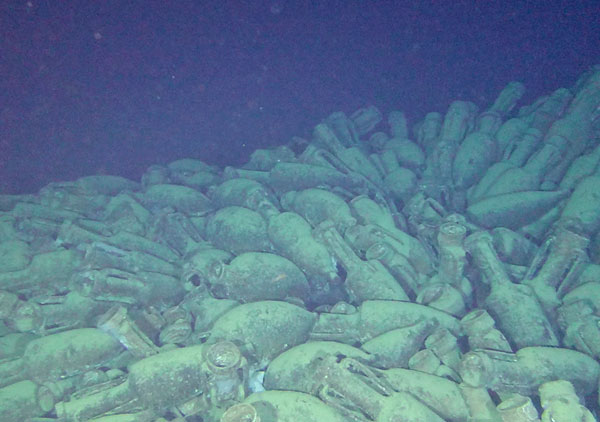

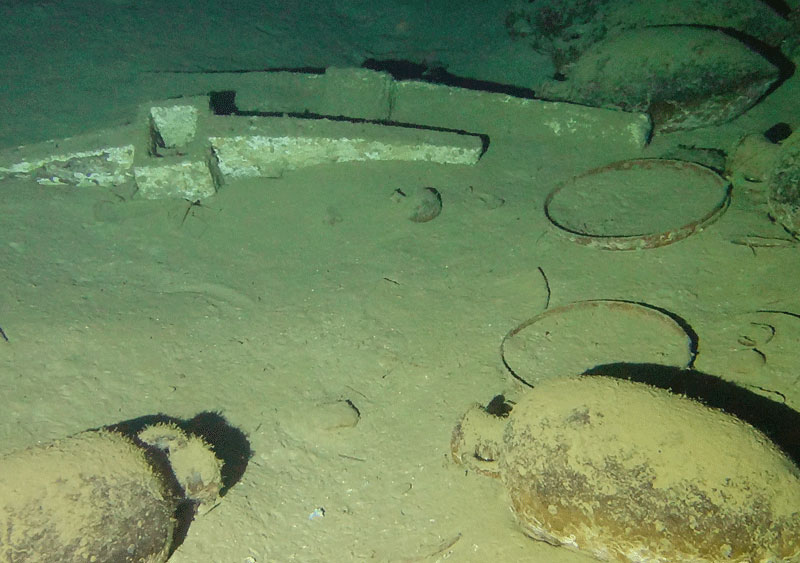
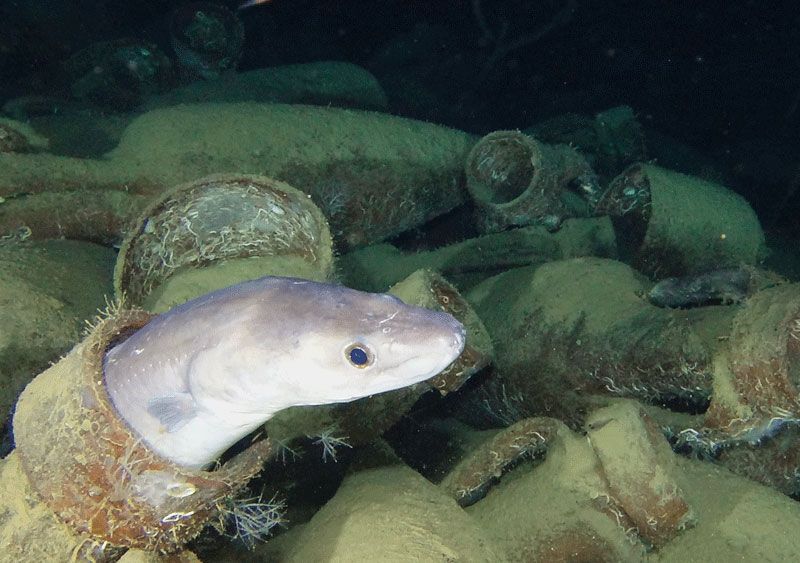
These vast amphorae deposits positioned on a uniform muddy bottom, provide shelter to delicious prawns, population of which drastically increase during breeding season (May-June) thus providing to fatten congers, ferrets, a kind of scorpion fish, Munida crabs whose chopstick like claws are maneuvered with lightning speed to catch nearby flying amphipods or sea fleas, Paromola spider crab known for using its last pair of legs to grab objects to position over its head and in certain occasions one can observe lobsters and groupers.
